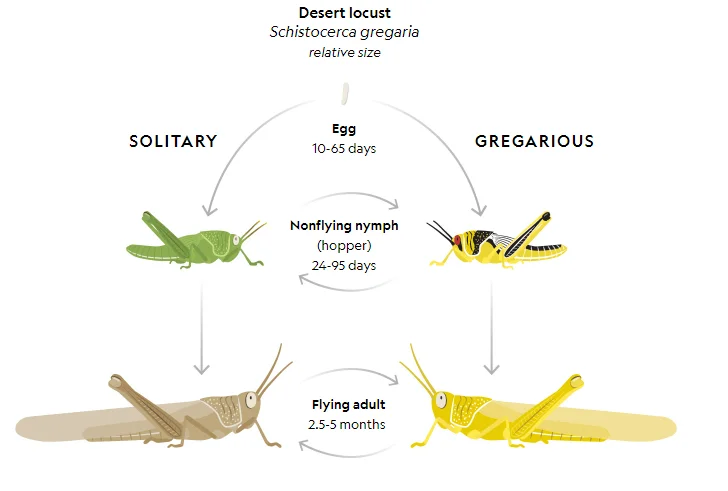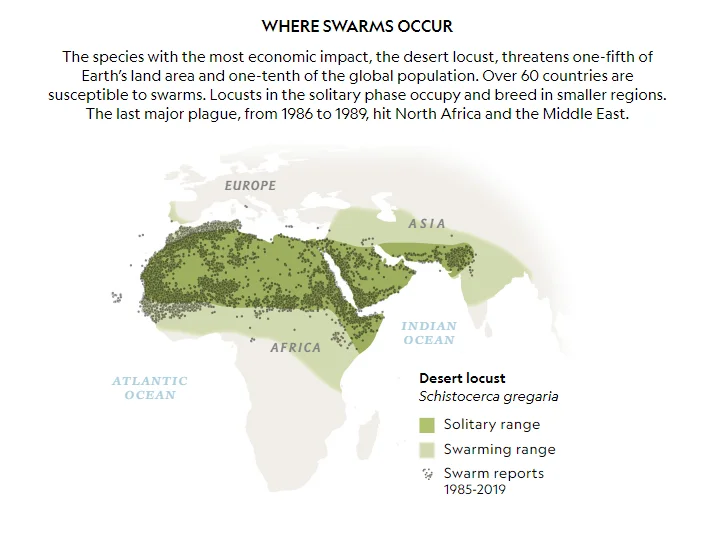Characteristics and Classification
Locust are large herbivorous short-horned grasshoppers that are distributed worldwide in a swarming phase. Locust swarm, characteristics, Effects and Lifecycle is described in this article.
- The name locust is derived from the Latin word ‘locusta’ meaning grasshopper that is large in size and periodically forms a large population and migrates long distances as destructive swarms.
- It is widely spread throughout Africa, Asia, Australia, and New Zealand. It occupies a vast geographical region according to their type of subspecies.
- In Europe, they are called large acridids whereas small species are called grasshoppers.
- The adult locust differs in color and physical appearance in two different phases. In the solitary phase, locust adjusts their color according to the surrounding with shorter wings and legs while in the gregarious phase, it forms black and yellow or orange color with a broader shoulder and long wings.
Scientific classification of migratory locust:
- Kingdom: Animalia
- Phylum: Arthropoda
- Class: Insecta
- Order: Orthoptera
- Sub-order: Caelifera
- Family: Acrididae
- Subfamily: Oedipodinae
- Genus: Locusta
- Species: migratoria
- Sub-species: migratorioides
- Other species of locusts are Schistocerca americana (American locust), Chortoicetes terminifera (Australian plague locust), Schistocerca gregaria (Desert locust), Nomadacris succincta (Bombay locust), Aiolopus simulatrix (Sudan plaque locust).
Behavior and life cycle of Locust
- Locust appears like an ordinary grasshopper but they are in big size and have long hind legs.
- They have two phases: The solitary phase and the gregarious phase.
- The solitary phase is the normal state while the gregarious phase is a physiological response to the changing environment.
- In an unfavorable environmental condition of drought, it triggers the physiological response to change the locust into a gregarious phase.
- When its body temperature rises, it starts to breed rapidly and produces winged adult swarms.
- They fly long-distance according to the frontal winds until they slow to the point where the wind starts blowing in an anti direction causing them to drop from the sky.
- The adult swarmers are the most powerful fliers and can travel great distances up to 1,500 meters per day.
- The swarms move around rapidly and strip all the field in no time and cause devastating crops.
Life cycle of Locust

(Source:https://www.nationalgeographic.com/animals/invertebrates/group/locusts/)
- The life cycle of the locust is either incomplete or direct metamorphosis.
- The development is in three stages: Egg, Nymph, and Adult
- The female locust lay eggs on the soil drilling a hole into the ground.
- They protect the eggs with the froth from desiccation, disease, and predators.
- The locust nymph sheds and hatches the wingless nymph but later develops increased wing size.
- Fledging occurs which is the final adult stage where wings are fully developed.
- For their survival and growth, they require green vegetation. The environmental temperature and living conditions specify the maturity of an adult locust.
Swarming nature of Locust
- Locusts shift from solitary phase to swarming phase with a specific signal which varies from species to species by Locust swarm.
- The desert locust shifts into a gregarious phase only with a touch on hind legs. Similarly, the Australian plague locust transforms with a touch on its antennae while other species react to sight and smell.
- This sensitive area triggers the level of serotonin which is the same chemical associated with mood swings in humans.
- Locusts can travel vast distances about 81 miles or more in one day and can remain in the air for a long time.
- The lengthy travel that the locusts had made is more than 3,100 miles in just 10 days in 1988 from West Africa to the Caribbean.
- They cause major agricultural damage and destroys a whole acre of crops in farming regions.

(Source:https://www.nationalgeographic.com/animals/invertebrates/group/locusts/)
Locust plaque

(Source:https://www.abc.net.au/news/rural/2020-04-21/western-nsw-suffers-locust-plague/12167946)
- Locusts are herbivores and can eat plants of its own weight each day which is about 2 grams only but the largest swarms can cause an outbreak in millions and billions together.
- This is called a locust plague which causes a devastating loss of crops and results in long-term effects on the economy of the entire region.
- In Western Africa, a plague of desert locust destroyed over 80% of crops that affected 22 countries which caused a loss of billion dollars.
- The desert locust covers a fifth of Earth’s land surface which is almost 60 countries and eats about 423 million pounds of the plant every day.
Relation with humans
- Locust does not cause any harm to humans and animals and is edible insects that are officially approved and are included in several cuisines in Switzerland, Cambodia, and many other countries.
- But eating locusts can be unsafe as it contains pesticides that farmers had used to protect crops.
- Climate change can affect the locusts swarming nature. Like the increase in temperature of the region favors the higher number of locusts that influences the locust plague formation.
Prevention of Locust swarming
- Once the plague is developed, it becomes impossible to control. Therefore, the best way to control the locust swarm is by implementing early control measures by monitoring the outbreak area and spraying insecticides and pesticides.
- Many locusts become predators of birds, reptiles, and mammals during swarming.
- The use of chemical control is quite expensive and environmentally unfriendly so researchers are involved in hormones that aggregate the locust in an early stage and can be killed.
- Other control measures include destroying egg masses and applying chemical insecticides in breeding and swarming ground.
Learn more:
References:
- https://en.wikipedia.org/wiki/Migratory_locust#Other_species_called_’locusts‘
- https://en.wikipedia.org/wiki/Locust#:~:text=Locusts%20are%20the%20swarming%20phase,behaviour%20and%20habits%2C%20becoming%20gregarious.
- https://www.nationalgeographic.com/animals/invertebrates/group/locusts/
- https://www.livescience.com/locusts.html
- https://theconversation.com/explainer-whats-behind-the-locust-swarms-damaging-crops-in-southern-africa-147129
- https://www.agriculture.gov.au/pests-diseases-weeds/locusts/about/about_locusts#lifecycle-of-a-locust
- https://www.britannica.com/animal/locust-insect